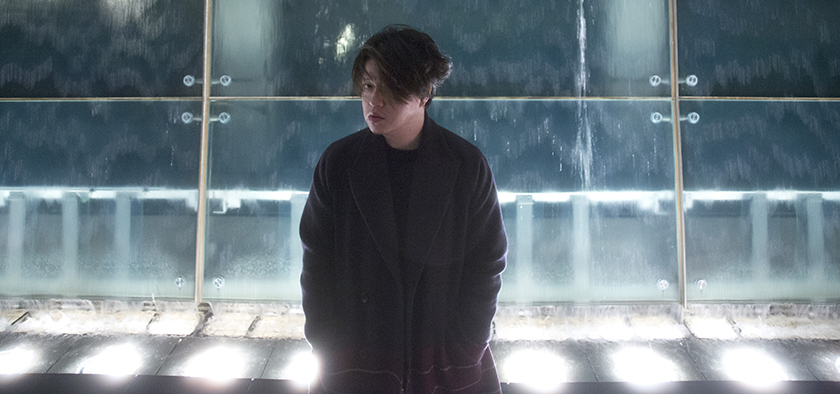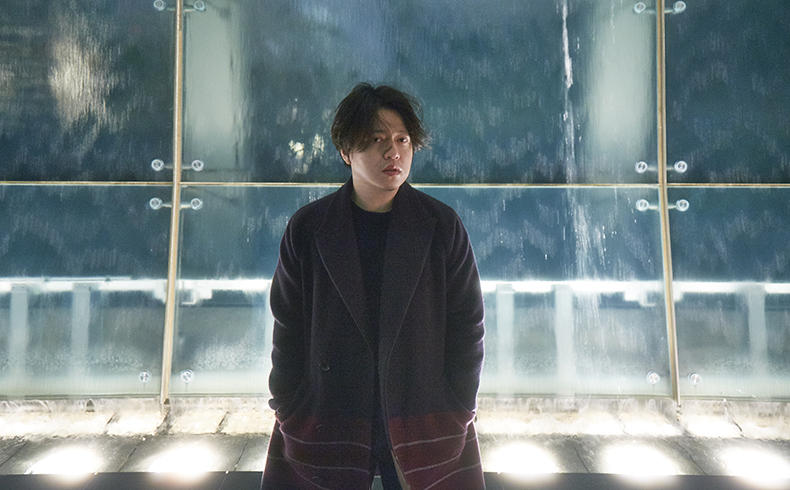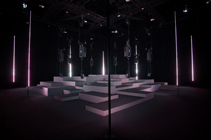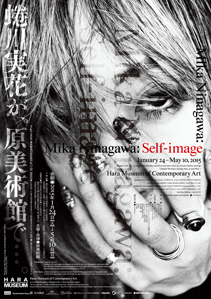


Technology, art, and music of the future
Android operas and sounds for public spaces
Musician Keiichiro Shibuya has his own label from which he releases cutting-edge electronic music by artists from around the world. He also collaborates with many artists, making music for movies and art installations, and producing live concerts. In 2013, he composed the world's first vocaloid opera "THE END", an opera starring only the vocaloid character Miku Hatsune and no humans. Shibuya works in both Paris and Tokyo. We began the interview by asking him about memories of his youth and learnt that he has long had ties to the Roppongi area.
Learning about music though CDs and scores
I was born and raised in Shibuya and went to high school in Hiroo. Roppongi is right nearby, so I was able to have a good look at the transformation of this area over the years. I often went to Roppongi WAVE to buy CDs. At that time, I'd just entered college and was doing many part-time jobs, and so had quite a lot of money. I often played the piano on part-time jobs. I also taught music composition to a child of a very rich family in Shibuya's Shoto district. The funny thing is that the boy was a big fan of Tetsuya Komuro and made music that were exactly like Komuro's. (laughs) I would correct the chords he'd written while eating cake that was served us. I don't know why I was asked to be his instructor, but every time I went, I was paid quite a big sum for a student.

Roppongi WAVE
A record shop that opened in 1983. It gained a loyal following, establishing itself as a place of the latest trends in music and culture, but closed in 1999 with the redevelopment of the Roppongi area. Roppongi Hills Metro Hat now stands in its former site.
Someone once said, "A person who borrows CDs and music sheets from other people will not make it as a composer," and those words stuck with me. I can't remember whether it was a music composition teacher or a senpai (elder) at university who said that. I guess it must have been a teacher since I didn't listen to my senpais. (laughs) Anyway those words made sense to me. I was studying contemporary music at that time so I bought a lot of contemporary music CDs and scores which I repeatedly listened to and read. Now that I think of it, I don't think any of the people who borrowed CDs then later became composers. When you purchase your own scores and CDS, you can read and listen to the music many times and that probably helps you to absorb and learn more.
I had many odd encounters at the Roppongi WAVE store. There was a time when a middle-aged guy who liked talking to artistic young people took me to a café on the first floor of the store for a conversation that lasted two or three hours. And once, when I was standing in front of a shelf that only nerdy people would be interested in, I noticed a girl nearby; we became friendly and had a hearty chat about music.
A place of the latest consumer trends
Roppongi seems to be a bit like Shibuya -it's a place of the latest consumer trends. The site of the Roppongi WAVE store later became the site for Roppongi Hills. In Shibuya, the HMV store later became the Forever 21 store and the Book First store became the H&M store. When people began buying CDs and books online, the stores were replaced with stores for clothes that people did not buy online. But now online purchases of clothes are becoming widespread, so I suppose the stores will change again. Roppongi certainly seems to be a place where the trends of consumers are very visible.
Nowadays, I often go to the museums in Roppongi such as the Mori Art Museum. Sometimes I drop by the antique watch shop 'Carese' on the third floor of Tokyo Midtown. I also visit SuperDeluxe. Twelve years ago, I set up the label ATAK; SuperDeluxe was the final stop on my very first tour and it's a memorable place for me. Many of my artist friends from abroad hold live performances there, and I often go on stage as a guest.
Super Deluxe
An event space that opened in 2002 on Roppongi Dori. Various events are held every night, including the "PechaKucha Night" by architects Astrid Klein and Mark Dytham.
Historic snow and Roppongi's magnetism
In 2014, the audio installation I made called "filmachine" was exhibited at "MEDIA AMBITION TOKYO." In a related event, I produced an electronic music event called "Digitally Show" on the 52nd floor of Roppongi Hills. I made the filmachine in 2006 at YCAM (Yamaguchi Center for Arts and Media) and so it had taken eight years for the installation to be shown in Tokyo. It's a huge, floor-to-ceiling installation with loud-volume multi-channels and LED lights. I felt that there was symbolic significance in the fact that this was exhibited at an art festival in Roppongi and not in an art museum.

filmachine
A huge, three dimensional sound installation made jointly by Keiichiro Shibuya and science researcher Takashi Ikegami. Consisting of platforms of different floor levels, 24 speakers and blinking LED lights, it was first shown in 2006 at the Yamaguchi Center for Arts and Media (YCAM), and later toured Germany and France.
Photo: © Michael Sauer - filmachine in Berlin, February 2008
In 2001, at the ROPPONGI THINK ZONE which Tokujin Yoshioka-san designed, I performed at an event called "OPEN MIND". I had just set up my own label and I remember feeling quite lost at the time: it was a period when electronic sounds and electronica were beginning to spread in Japan, and doing a live performance with a laptop was a fresh experience. I felt a sense of excitement and wonderment at how things were going to be in the future.
ROPPONGI THINK ZONE
An art space, now closed, that was set up in 2001 on Roppongi Dori as a project preceding the construction of Roppongi Hills. It was a venue for numerous innovative events using experimental images and sounds.
I produced "Digitally Show" hoping to create a similar event where people could feel they were experiencing something new. It was an electronic music event, but the music wasn't just for dancing. At the same time, it wasn't entirely the experimental kind of music which leaves people standing still on the floor. I thought we should have music that felt fresh, and was physical and fun. I did this with Daito Manabe-kun and Masaya Nakahara-san (of Hair Stylistics). We combined many elements ranging from digital to analog and minimal to noise. It was an event that was difficult to define though, so I thought maybe people would find it difficult to understand.
On the day of "Digitally Show", we had record-breaking snow in Tokyo and all the public transport like trains and subways were halted. Yet the event was sold-out and the place was packed. I couldn't believe my eyes. First the snow, and then all the people - there were two surprises that day. I realized then that Roppongi has some sort of magnetism that draws people and that it's a place with compatibility for new things.

The universally understood appeal of contrasts
I currently go back and forth between Tokyo and Paris, spending about the same time in each city. In 2013, we were able to successfully hold the vocaloid opera "THE END" in Paris. Just when I was wishing I could live in Paris, I was invited to an artist-in-residence program at the Palais de Tokyo. They said they would lend me a studio inside the Théâtre du Châtelet - the oldest theater in Paris. They were providing me with accommodation and work; it was an offer I could not pass up, so I immediately said yes.

THE END
An opera featuring electronic music, the vocaloid "Miku Hatsune" and computer graphics. It was performed in May 2013 in Tokyo and in November of the same year at the Théâtre du Châtelet in Paris. Each time, the opera was the topic of the town and tickets were immediately sold out.
ill, dir. by YKBX
©CFM
©LOUIS VUITTON
Photo: KENSHU SHINTSUBO
Théâtre du Châtelet
©A4A
I feel comfortable living in Paris. Japanese people like to meet and discuss things, and meetings are held even for matters that could easily be discussed on the phone. But in the studio in Paris, we only have a few, very short meetings. I don't have to make as many interviews as in Japan, and I can concentrate on my work. I'm a workaholic; when I'm in Japan I make music every day, staying up through the night and early hours. But the French don't work late into the night, so I'm treated as a bit of weirdo for working late in the theater. (laughs)
The music I made recently in Paris sounds clear, and I wondered - perhaps tritely -if this is because of the expansive Parisian skies. I don't change my music for different audiences though. In fact I think it's better to do things in a Tokyo-like way. Innovative projects that incorporate digital technology are enhanced when they are held in places like old theaters. The contrast of old against new is very appealing, and its charm is understood and appreciated in every country.
Looking at the creativity in Tokyo today, I feel concerned that there is not enough contrast - everything seems to be digital and futuristic. Works which are excessively digitalized attract only people who like new things. On the other hand, classical things draw only conservative people and older people. But when the old and the new come together in ways that have not been tried before, a sort of warp in reality occurs - a warp in time and space. Instead of basing everything on the old or on the new, it's important to take a step back, give equal consideration to both elements and think about how to effectively combine them in a way that resonates with people. And when you can create parts where the old permeates the new, or vice versa, the fusion leads to a more powerful form of expression.
Being influenced by outer factors
The music comes to me when I'm still in the middle of discussions with clients. Being a very positive person, my mind takes note of only the essential facts. For example, if I'm told that the story is about a person with supernatural abilities, my mind grasps the story setting, but it ignores other unimportant data. So it ignores comments such as "We want it to be like the music in the movie so-and-so." (laughs) There was once a time when I surprised a client by starting to play the piano in the room as soon as discussions ended, saying, "Maybe this is the kind of melody you have in mind." I have no problem with getting short-notice requests such as completing something in three days.
When making "THE END", the initial plan was for me to perform in it, but then someone said it might be interesting if I made an opera for Miku Hatsune. That suggestion started to change everything. We decided to use a lot of computer graphics. And I thought that if we were going to use computer graphics, tension chords would sound too weak and it would be better to have do-mi-so chords... The outer factors affect the way I make my music and I find that interesting. Maybe that's why people say my music doesn't seem to belong to a specific genre or that it seems to reflect different kinds of tastes.
When composing for Hiroshi Sugimoto-san's movie, I was inspired by "Architecture" and thought of doing the same thing musically. When you hit the keys really hard using the force of both arms, you get a clashing sound that is very piano-like - very contemporary music-like, you know? (laughs) But when you eliminate that attacking sound, you are left with a resounding echo, and when that echo is extended until it completely disappears, you get a soft, lovely, melting sound. People think that piano music is about the clashing sounds, but the clashing sounds are actually very fleeting, and the airy, cloud-like echoes last much longer. It occurred to me that the essence of the piano lies in those echoes, and so I made music by putting together numerous computer-recorded echoes.

Architecture
Series of photographs by Hiroshi Sugimoto depicting Modernist architecture designed by famous architects, such as the Villa Savoye by Le Corbusier. The photographs were taken with the focal length of the camera lens set to twice-infinity. The blurred outlines make the viewer focus his attention on the form of the architecture.
The Roppongi Hills Arena and summer nights
I'm currently collaborating with Hiroshi Ishiguro-san, the robotics researcher at Osaka University; we're trying to make an opera performed solely by androids. A lot of research has been made into the facial expressions and movements of robots, but I personally think robots in general look a bit ugly. (laughs). I wanted more beautiful looking robots, so in this project, we created our first robot using molds made from a real human model.
Recently Katsuya Kamo-san did the hair and the make-up for the robot, and Kenshu Shintsubo-san took photos of it. At the upcoming exhibition at the Palais de Tokyo, the photos are going to be shown together with the actual model. When you work only in the academic world, you tend to overlook the things that are unexplainably cool or things that are simply beautiful. Musicians can overlook these things too when they are focusing only on the academic aspects.
I just had a thought: The Roppongi Hills Arena is like the sort of outdoor amphitheater you find in countries like Italy, isn't it? It would be nice if we could do something there on summer nights. I've been involved in many experimental projects, and most of them have been held in white box-like rooms with low ceilings. The white cube doesn't seem new now, so it would be very interesting if we could have events held outdoors.
I had an experience that was pivotal for me. I was doing a solo piano concert in the garden of Hara Museum of Contemporary Art. In a music hall, the sounds are bounced back when I hit the keys hard, but I found that outdoors, the sounds just disappear into the sky. I waited for the sounds to fade and changed the way I play. And the audience also seemed to find it pleasant to be in a place without a roof. I was surprised to discover how stress-free it felt to have no sounds bouncing back.

Designing sounds for buildings and spaces
I have a keen interest in making sounds for various spaces and environments. I've already been engaged in a few projects for condominiums and public spaces where the music has been installed permanently, but I would like to make more music and sounds for commercial facilities and buildings.
Tokyo Midtown for example, is filled with all kinds of sounds: the BGM within the facilities, the sounds of the elevator, the voice making announcements, as well as the so-called "sound logos". Public spaces are overflowing with many kinds of sounds. I think it would be a good idea to have musicians design sounds for space just as an architect designs buildings. It would be ideal if I could do everything myself, but perhaps it might also be interesting to have different artists make sounds for each floor of the building.
I've made a sound system for public spaces called "unformed" with sound artist evala-kun whom I've been working with for a long time. It's a very simple device. Right now, it's on display at the "Mika Ninagawa: Self-image" exhibition at Hara Museum of Contemporary Art playing music I made music for Ninagawa-san's images. The tone is kept within a certain range, but the music has been programmed to continually change. You can stay there a long time but the same music is never repeated.

Mika Ninagawa: Self-image
An exhibition of Mika Ninagawa's works, centering on the artist's self-portraits. About 150 works are on display, including works shown for the first time. Keiichiro Shibuya composed the music for the audio-visual installations. The exhibition at Hara Museum of Contemporary Art will be on until May 10, 2015.
The futility of focusing on demand
I hope that Roppongi will continue to be an innovative place for design and art. By "innovative" I mean a place that is creative regardless of demand. I think too much attention is being placed on demand and what people are assumed to need; it leads to fruitless efforts. This is something that can be said not only of Roppongi but of Tokyo as a whole. When you step out of your world and look at the bigger picture, you realize that no need exists for art or music. What exists is people's reaction to works that are released. In Tokyo in particular, there is such an enormous amount of information, and it's pointless to place importance on what people need. If you do that, you lag behind.
Instead of trying to do things in line with demand, one ought to think about creating proper works that can be shown to people. The "filmachine" I made at YCAM is in Yamaguchi City. The elementary school children living near the art center have grown up seeing innovative works from around the world, and apparently they make things from cardboard that look like media art objects. It makes such a difference when you've seen genuine things from a young age. I hope Roppongi becomes a place like that.
The process of moving forward
I said earlier that I feel comfortable living in Paris, but compared to Tokyo, there are a lot of things that Paris doesn't have. There are few automatic doors, there are no elevators in the subways, and many places are without Wi-Fi connection. It's inconvenient, but because of the inconvenience, there is time to think. I am not necessarily in favor of all the advances being made in technology and lifestyle. Of course, I don't think we should go back to inconvenient times, but I'm concerned that in making progress, we risk going in the wrong direction.
A while ago, I released a CD called "Sacrifice" from my label; photographer Shin Suzuki-kun took the photos for the jacket, using a high-resolution camera called "Phase One." When we came to the step of printing, I learnt that in Japan, the printing costs are high because subtle adjustments are made, whereas in China where no such adjustments are made, the costs are low. Because of our budget, we had the printing done in China, and it turned out fine because the resolution was so high in the first place. I thought it was frightening how the craftsmanship of making subtle printing adjustments had been made unnecessary by advanced technology. But I suppose that is the reality of technology.
If people watch our android opera and find themselves being moved to tears by looking at non-human things that look so human, I think they will feel frightened. They might feel that their identity as human beings is being threatened. But I believe we need to keep taking challenges; it's by taking challenges that we create the future of technology art. I think the future is about the process of pushing forward despite the feeling of fear.
Editor's thoughts
When we met for the interview, Shibuya-san greeted me with a broad smile. "We were riding on the same train. I saw you studying very intently. You seemed to be absorbing [information] as fast as a bear drinking water," he remarked. Indeed, I had been using my iPad to prepare for the interview, reading past interview articles and viewing footage of Shibuya-san's concerts and installations on Youtube. What a surprise to learn that he had been sitting right in front of me the whole time!(edit_kentaro inoue)



















